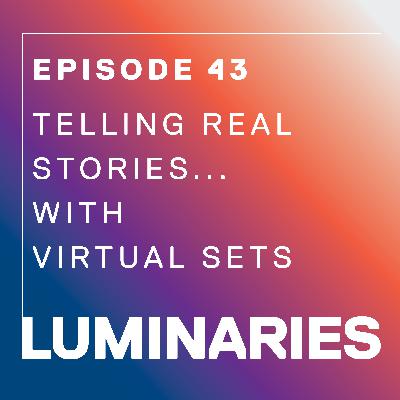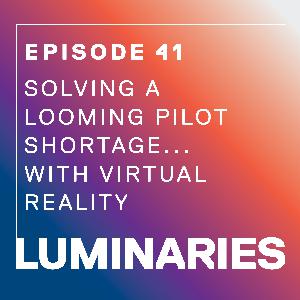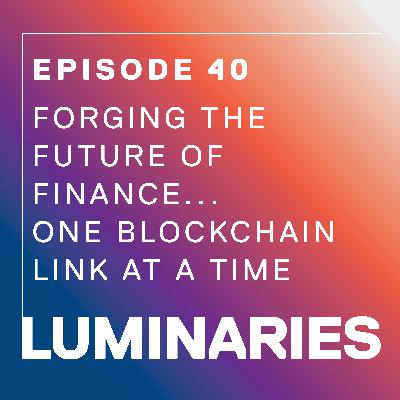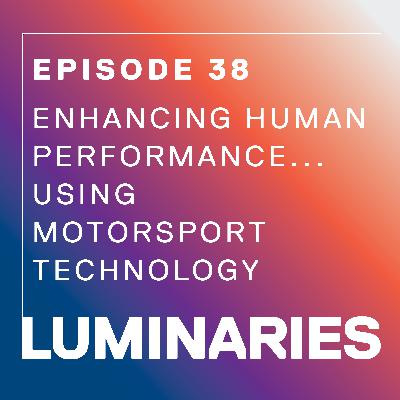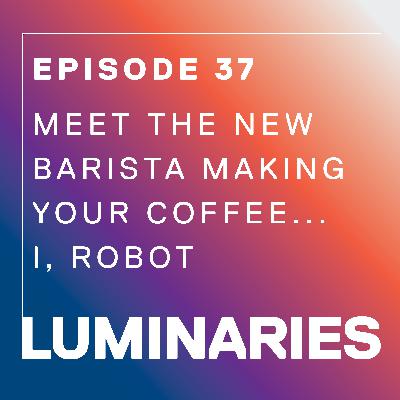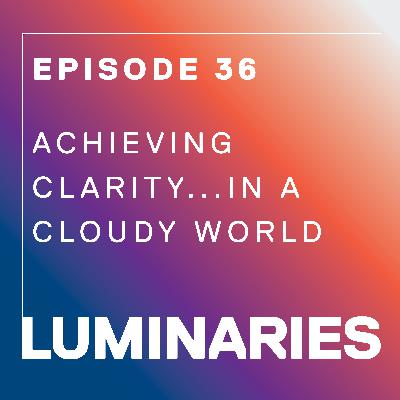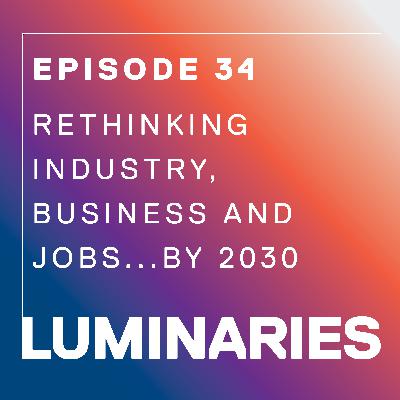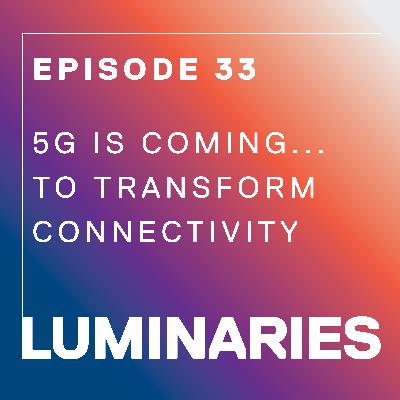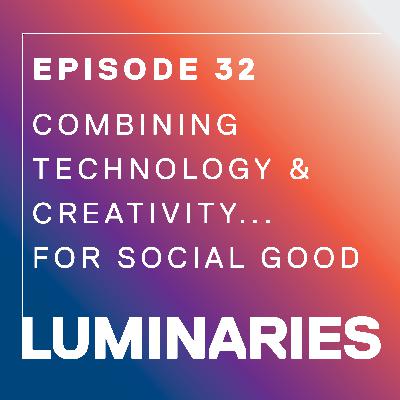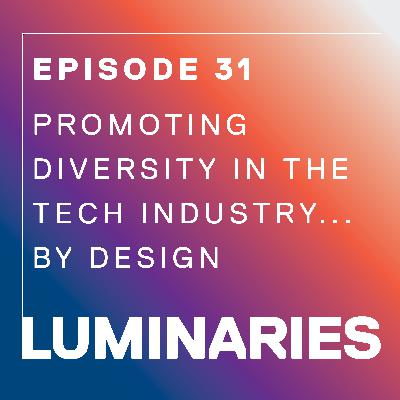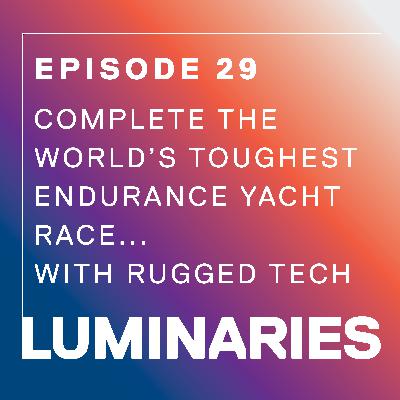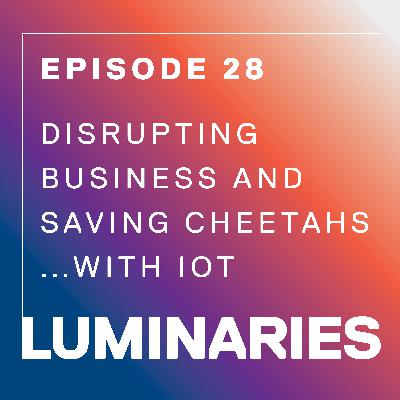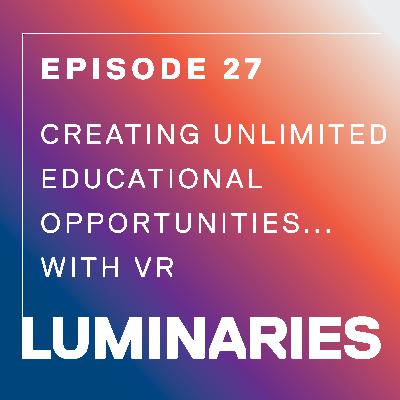Discover Luminaries - Talking to the Brightest Minds in Tech
Luminaries - Talking to the Brightest Minds in Tech

Luminaries - Talking to the Brightest Minds in Tech
Author: Dell Technologies, Mark Schaefer, Douglas Karr
Subscribed: 140Played: 808Subscribe
Share
© 2018 Dell Inc.
Description
True visionaries in technology focus on enabling positive human progress. We invite you to meet exceptional technology leaders from our analyst, partner and customer communities as well as from the Dell Technologies family of IT companies. Hosts Mark Schaefer and Douglas Karr will be your guides on an expedition plotting the paths of IT transformation and business growth.
43 Episodes
Reverse
Listen In To Learn:
How volumetric video and virtual reality could revolutionize medicine, education, and more
How virtual sets are helping the film industry reduce environmental impact
How these technologies can democratize storytelling, helping underrepresented populations tell their own stories
Hollywood's Alternative Soundstage
Imagine shooting a film on location in Tokyo, Paris, and London… all without leaving a soundstage in California. Each environment is digitally rendered in such detail that you can place lights, move cameras, and film on the virtual set just as you would a physical one.
Now imagine that technology used for training medical students: A virtual reality headset could replicate a state-of-the-art operating room with millions of dollars’ worth of equipment. And each student could have their own.
Sony Innovation Studios is pioneering “volumetric video” – the process of scanning sets in 30k resolution to reproduce them in three-dimensional virtual space. Explore the possibilities of this groundbreaking technology with studio President Glenn Gainor.
Listen In To Learn
How to reduce risk and get buy-in for digital transformation
How to identify the right starting point to begin the process
The guiding principles of leadership during transformation and beyond
How to address the four most significant barriers to transformation
The Human Element of Digital Transformation
“The shoemaker’s children go barefoot.” It’s a common proverb that applies across industries: The thing you do best for others can be the hardest to do for yourself.
Dell Technologies is leading the charge for digital transformation. They help businesses reinvent themselves through technology to run faster, more efficiently and ultimately to greater success. It’s up to folks like Greg Bowen, SVP, Digital Acceleration & CTO, Dell Digital, to make sure that the same transformation is happening internally.
Greg is accelerating Dell’s digital transformation by looking beyond just technology. For Greg, it’s a human challenge as much as a technical one – the challenge of convincing 10,000 employees to make radical changes in the way they work. Using Pivotal Labs methodologies, Dell is making a tremendous shift in how its own IT organization, called Dell Digital, operates to quickly design, develop, iterate and deliver new products and capabilities.
Greg explains how the process is underway at Dell Digital, the IT organization that supports Dell, and how you can get started with your business.
Listen In To Learn:
How data-driven instruction can accelerate learning
How virtual reality can promote diversity in a recruitment process
How “vertically integrated training” can solve labor shortages
The Looming Crisis in the Aviation Industry
Pilots must retire at 65 by federal mandate, and there aren’t enough new pilots coming in to balance the aging population. The existing model for pilot training is part of the problem: It’s costly and time-consuming for potential recruits, with barriers of entry that tend to narrow the applicant pool and discourage diversity.
Ed Bagden and his team are looking to combat the problem by creating a new model for pilot training. LIFT Academy uses virtual reality to help diverse candidates visualize themselves in the captain’s chair. Then applicants have access to subsidized, tech-enabled training with a guaranteed career path. On this episode, Ed explains how virtual reality, data mining, and machine learning can all be put into play to solve the pilot shortage.
Listen In To Learn
How blockchain can streamline financial transactions
A long-term investment plan for blockchain implementation
Practical use cases for blockchain technology
The Australian Securities Exchange Is Getting Real with Blockchain
Of all the exciting new technologies on every business leader’s mind, blockchain may be the most discussed and least understood. Experts say it has the potential to transform every type of transaction. It’s said that blockchain could make banking obsolete and streamline your supply chain. There seems to be endless potential, but not a lot of clarity. And even fewer practical implementations to use as models.
The ASX is building a blockchain implementation for finance, a platform where a trusted network can explore the possibilities. Dan Chesterman is the CIO of the Australian Securities and Exchange (ASX) and he’s had to cut through the hype to create something that actually works on the ground level. In this episode, Dan explains exactly what the ASX is working on – how it’s built and what it will do when it’s done. It’s a rare and fascinating practical look at a technology that is frequently more sizzle than steak.
Listen In To Learn:
How to choose durable, reliable technology for years of use
How to build more efficient data centers
How creativity and technology combined to create a $330 million science center
Creativity and Technology Combine to Power a $330 Million Science Museum
Brooks Weisblat started his career with a degree in biology and an interest in a promising new technology: The world wide web. He started work as a web developer at a small science museum in Miami… and two decades later, he was planning the technological backbone for a $330 million new building.
The Philip and Patricia Frost Museum of Science is a 250,000 square foot state-of-the-art marvel. Every part of it, from the exhibits to the wildlife tanks to the gift shop, uses the latest technology to keep it running smoothly and efficiently. Building these interconnected systems was a massive undertaking for Brooks and a small team of developers.
In this episode, Brooks talks about the challenges he and his team faced in planning these systems. Brooks and his team had to get creative to build robust, redundant, but also space and resource-efficient systems for everything from shark tank life support to mobile point of sale devices.
**Listen In To Learn: **
How McLaren diversified into Health and Human Performance
How breakthrough innovations come from the intersection of art and computer engineering
How big data is sparking innovation in health care
How to build credibility in a an established industry
Formula 1 Is More Than Just Winning Races
Sure, winning Formula 1 racing is done on powerful analytics but for McLaren Applied Technologies, their ability to innovate reached break-neck speed when they decided to take their learnings and apply them beyond racing, and into health and human performance. Harnessing the sensor and data analysis capabilities developed in Formula 1, McLaren Applied Technologies creates digital therapeutic solutions that optimize and personalize treatment for better clinical outcomes.
On this week's episode, we steer into the fast lane with Duncan Bradley, Health & Human Performance Business Unit Director, as he discusses how McLaren Applied Technologies takes data from our bodies to enhance human performance.
Listen In To Learn:
How robotics is connecting customers to the perfect cup of coffee
Why having a sustainable supply chain is important to Briggo
Why the future is not filled with robot workers but a human-machine partnership
How to use data to create a better customer experience
How diversity and inclusion helps Briggo to be an innovative technology company
Even A Good Cup Of Coffee Can Have A Good Technology Story Behind It
Employees being afraid of robots taking their jobs is not a new storyline. But if a machine can make up to 100 cups per hour, 4 times the number of a traditional barista, are these fears really unfounded? Well, don't worry because the truth is that robotics still create more interesting and challenging opportunities for people to work versus taking away.
Briggo's vision is to provide their customers a Connected Coffee experience, a confluence of digital and physical experiences that drives growth and on-demand delivery of perfect cups of coffee through data and robotics.
On this episode, Marsha Osborn, Chief Operating Officer, discusses what drives Briggo to be so passionate about their relationships with the bean supplier, their team, and their customers.
**Listen In To Learn: **
The evolution of a multi-cloud world
Why adopting a multi-cloud model requires significant organizational culture change
What the cloud announcement at Dell Technologies World 2019 will mean for customers
Why clarity is required to pick the best cloud platform to meet your modernization goals
How to remain relevant in technology given the pace of change
How will cloud fuel widespread adoption and evolution of artificial intelligence
The personal characteristics it takes to lead transformational change
Listen In To Learn
How to deliver a user-based experience that leads to customer retention
How tech is bringing past icons back to life and delivering customers an immersive experience
How to design a future-ready tech transformation
How emerging tech, like VR and AR, will come into play
Setting A New Standard for Fan-Focused Technology
The Naismith Memorial Basketball Hall of Fame is more than a museum. It's an experience. Thanks to an $18 million technology transformation, fans are now able to connect with their childhood heroes and honor the legacy of players past.
When the museum was built in 2002, the technology featured throughout was state of the art. But 15 years later, it was considered tired and outdated, and keeping the museum relevant and interesting to a new generation of people was the name of the game. Their goal, with technology transformation as a heavy part of their behind-the-scenes transformation, was and is to redefine how halls of fame represent their famers.
On this episode, Jason explains how the Hall of Fame is using technology to honor the living history of basketball, by delivering visitors an experience that keeps you educated, focused, and, most importantly, entertained.
Listen In To Learn
What jobs of the future will look like
The importance of STEM and diversity in developing digital skills
How to approach security risks in a multi-cloud environment
Innovation emerging from developing countries creating new industries and job growth
Leading your business through digital transformation
How diversity in your workforce differentiates you from your competition
Technology Will Eliminate The Historical Friction Of Transactions And Processes We've Been Accustomed To In Our World
The world as we know it, is changing. As humans increasingly partner with machines to transform the way we do business, research suggests that emerging technologies will open up new ways of creating value and the advent of new industries and business growth.How can you prepare your business for these shifts? According to Aongus Hegarty, President Europe, Middle East and Africa (EMEA), Dell Technologies, we need to focus on the skills and requirements of the future, because the future is bright. Innovation is abundant in developing countries, setting the example of how an investment in digital literacy and diversity and inclusion will unlock the next generation of digital leaders. On this episode, Aongus explains how he sees the increasing use of emerging technologies shifting the economy over the next 10 years and what he believes will be the key to leading through this change successfully.
Listen In To Learn
How 5G will impact AI applications, self-driving cars, telemedicine and more
The timeline for 5G rollout and adoption
What makes 5G different from any previous broadband technology
How 5G will drive business innovation
How Dell is participating in developing and innovating with 5G
Faster Mobile Broadband Is Just the Beginning for 5G’s Potential
5G connectivity is almost ready for primetime. Wireless providers, broadband providers, and device makers are all readying a major push to roll out the technology.
While 5G will substantially improve download speeds, it’s more than just faster data transfer. Vast improvements in latency and connectivity will drive dozens of up-and-coming technologies like self-driving cars, telemedicine, always-connected computing, and IoT-enabled sensors. 5G has the potential to transform existing businesses and enable entirely new business models.
Dell is working with technology partners around the world to help make 5G a reality. On this episode, Liam Quinn, Senior VP and Senior Fellow at Dell, discusses the technology’s potential, what business applications can benefit most from it, and how it will change our daily lives over the next decade.
Listen In To Learn:
How STEAM (Science, Technology, Engineering, Arts and Math) education can elevate under-served populations
How technology can make a sustainable, scalable social impact around the world
How to promote a productive cross-conversation between science and the arts
Reshaping the World through Technology, Science, and Art
We often hear about the specific ways technology will either save or end the world. AI is going to revolutionize how we work! Or, it’s going to lead an army of killer robots to our doorstep. Should we embrace the latest technological advancements, or run screaming?
The truth is, the future will be shaped not by the technology itself, but by the way humans choose to use it. To make these choices wisely, we need people who are educated, scientific-minded, and engaged – but who also have creativity and ingenuity to spare.
For Sally Eaves, the key to unlocking a healthier, more prosperous future is that fusion of humanity, creativity, and technology. Sally is an emergent technology expert, CTO, public speaker and author. In this episode, she shares how her organization is bringing technology and arts education to underserved populations around the world. Listen in and catch her enthusiasm for how transformative the right tech with the right mindset can be.
Listen In To Learn:
How to address the cultural issues that limit diversity in tech
How to broaden the labor pool for the next generation of tech workers
How technology can connect employees, help examine intrinsic bias, and create dialog
How data can drive a better employee—and ultimately, customer—experience
Diversity and Gender Equality Could Solve Tech's Talent Gap
By recent estimate, there will soon be roughly one million open jobs in the tech industry. The existing labor pool can only handle about half that amount. It's a looming crisis – and one that could potentially be resolved through equality and diversity initiatives. Not only are fair hiring practices the right thing to do, they just make the most business sense. Karen Quintos is the Chief Customer Officer at Dell and the founder of Dell's women in Action Employee Resource Group. On this episode, she explains how Dell brings together technology and training to overcome bias, promote equal hiring and equal pay practices, and build a strong and diverse workforce.
Listen In To Learn
How scientists are working to eliminate bias and error in AI training
How practitioners are developing algorithms that can win FDA approval
How AI can supplement and even exceed human capability in reading medical scans
What’s coming next for AI in healthcare
New Algorithms Could Detect Eye and Brain Disorders Earlier than Humans Can
Eyes are more than the “windows to the soul.” They’re the visible parts of our nervous system, an extension of the brain that breaches the safe house of the skull. As such, ocular health and neurological health are intertwined. The most skilled ophthalmologists can read ocular scans to not only look for eye disease, but also traces of a host of neurological disorders.
Voxeleron is using artificial intelligence and machine learning to, as they put it, “democratize expertise.” Their algorithms hold the promise of delivering expert-level diagnostic capabilities to any lab with a scanning device. What’s more, their algorithms already show signs of exceeding human capability in predicting certain eye diseases.
Jonathan Oakley and Daniel Russakoff, both Principal Scientists at Voxeleron, outline the methodology they use to train AI up to clinical standards. They also offer a fascinating look at just how far the technology has advanced already, and what the future holds for AI in healthcare.
Listen In To Learn
How advances in technology have made sailing safer
The role that technology plays for all of today's sailors
The extreme environments of a round the world race
How tech has allowed spectators to keep up to date with the race whilst remaining on solid ground
Tech That's Tough Enough To Withstand Mother Nature's Wildest Conditions
In a 40,000 nautical mile race around the world in 70-foot racing yachts where nearly half the crew have little to no sailing experience, the Clipper Round The World Race is not for the faint hearted. Experiencing extreme heat, condensation, corrosive salt water and numbing cold, it's only the toughest of tech that will survive and see each team through to the finish.
In this fascinating episode, Sir Robin Knox-Johnston, Founder and Chairman of the Clipper Round the World Yacht Race, paints a vivid picture of life at sea. He takes us below deck to explain the training and preparation required to sail a yacht around the world, the tech that keeps spectators up to date with race conditions and the scariest experience of his life on the water.
Listen In To Learn
What are the opportunities for VR to lead in educational training?
What’s in the future for VR?
What are some of the obstacles and hurdles to overcome in order to make VR adoption more widespread?
How immersive virtual experiences like CAVE are being applied in particular industries
Virtual Reality (VR) Isn't Just For The Video Game Industry
VR opens up an amazing array of possibilities for the arts, sales, exhibits and more. For educational training, it allows for field training in areas we never imagined. Instead of engineering students creating bridge models out of toothpicks, why not build a model in VR and let it truly come to life.
In this podcast, Dr. Carolina Cruz-Neira scholar and faculty member at the University of Arkansas dives into VR opportunities for education. She takes us behind the curtain into her career progression, starting as a dancer, and her climb to develop CAVE (Cave Automatic Virtual Environment), an immersive VR system: think of it as a version of a holodeck (yes, like in Star Trek). Listen now to dive into the opportunities and challenges VR can bring.
Listen in to Learn:
• How technology is changing lives in India, Nepal, and beyond
• How the right tech supports humanitarian and conservation work in the most extreme environments
• How to find motivation and passion to pursue your goals
National Geographic’s Adventurer of the Year Brings Purpose to Global Adventure
If your laptop crashed right now, you might lose some valuable data. But it’s likely not a matter of life and death. Now imagine you’re in Siberia, the temperature is -67 degrees, and your gadgets are the only things keeping you alive and warm. That’s an average day at the office for Mike Libecki.
Mike has made more than 80 expeditions to some of the most extreme environments on the planet, seeking to capture the beauty of the natural world and make it accessible for the rest of us. His journeys inspire us to see that nature is amazing, breath-taking, fragile, and in need of our protection.
Now, Mike’s on a mission to bring technology to the developing world, a joint venture with his 15-year-old daughter-and-adventuring partner, Liliana.
Listen in as Mike shares incredible stories of global travel, close encounters with polar bears, and how technology can help make the world a better place.
Listen in to Learn:
• How to capture data in context that that makes it meaningful
• How to safely store data in an easily-retrievable format
• How to build a robust data backup system
• How space exploration is moving toward data-driven discovery
Collecting and Storing Scientific Data Is Keeping Astronauts In Space
What’s the most valuable data you store in the cloud? For most of us, it’s pictures of family and friends. These photos are priceless to each individual, certainly. It’s definitely worth storing a backup in the cloud and having them on a local disk.
Now imagine your data was priceless not just to you, but to the entire human race. How would you store, say, images from the last moon mission? How would you capture not just the data, but the context that makes the data meaningful, and then preserve it for future generations? Most importantly, how would you keep data secure and make it freely available around the world?
Answering these tough questions is a full-time job for Tom Stein, NASA Planetary Data System Geosciences Node Operations Manager at Washington University. On this episode, Stein explains how he and his team collect, preserve, and distribute terabytes of irreplaceable data generated by the space program, data that is ultimately being used to inform and improve the space program.
Listen in to Learn
Why company culture is critical in driving technological innovation
How introducing new technology into a traditional workplace can be an easy transition
How critical it is to understand your customer's needs and pain points
The next disruption in railway? The Railway Internet of Things (RIOT)
How Innovation in IT Leads to New Revenue Streams
IT is generally considered a cost center in organizations. At best, we see the IT department as providing vital infrastructure to support the business; it’s part of the operating cost, not really an investment that pays dividends.
Jason Brown, the CIO of Rio Grande Pacific, is out to change that perception. He believes the IT department can be a source of innovation, finding new ways to meet customer needs – and, yes, generating revenue.
In this interview, Jason shares how Rio Grande Pacific stays nimble and aggressive, moving faster than their larger competitors. He also discusses how to overcome resistance to change and get organization-wide buy-in to adopt new technology.
Listen to the episode to learn how Jason’s IT department unites marketing, R&D, and customer service to create solutions that fit the company’s niche market.


